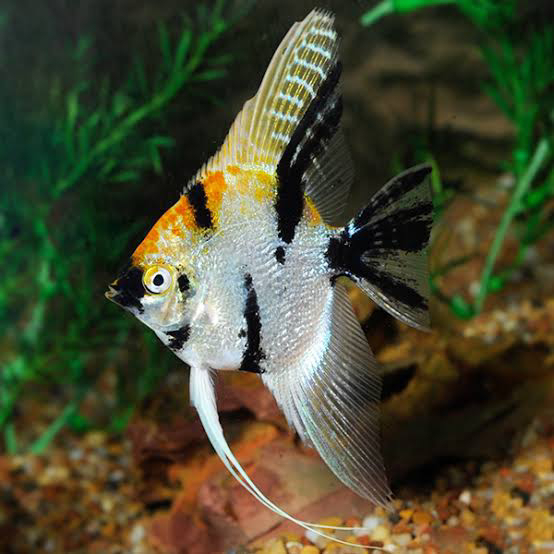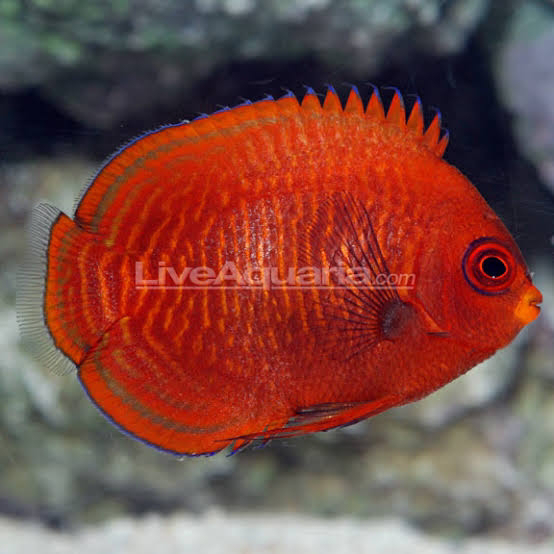As is the case for other cichlids, brood care is highly developed. All Pterophyllum species originate from the Amazon Basin, Orinoco Basin and various rivers in the Guiana Shield in tropical South America. Naturally occurring angelfish are frequently striped transversely, colouration which provides additional camouflage. Angelfish are ambush predators and prey on small fish and macroinvertebrates. Pterophyllum is a small genus of freshwater fish from the family Cichlidae known to most aquarists as angelfish. Eggs are generally laid on a submerged log or a flattened leaf. This body shape allows them to hide among roots and plants, often on a vertical surface. All Pterophyllum species form monogamous pairs. The three species of Pterophyllum are unusually shaped for cichlids being greatly laterally compressed, with round bodies and elongated triangular dorsal and anal fins.
Scientific classificatione ;
Kingdom:
Animalia
Phylum:
Chordata
Class:
Actinopterygii
Order:
Cichliformes
Family:
Cichlidae
Tribe:
Heroini
Genus:
Pterophyllum
Heckel, 1840.
Species ;
P. Gosse, 1963) Amazon River (between Manacapuru and Santarém), Essequibo River and Rupununi River.
Pterophyllum scalare adult.jpg Pterophyllum scalare (Schultze, 1823) (freshwater angelfish) Amazon Basin in Peru, Colombia, and Brazil. Image Scientific name Distribution
Altum.jpg Pterophyllum altum Pellegrin, 1903 Orinoco River Basin and the Upper Rio Negro watershed in Southern Venezuela,
Southeastern Colombia and extreme Northern Brazil
Pterophyllum leopoldi.jpg Pterophyllum leopoldi (J.
Breeding :
In situations where the eggs are removed from the aquarium immediately after spawning, the pair is capable of spawning every seven to 10 days. During this period, the fry survive by consuming the remnants of their yolk sacs. scalare reaches sexual maturity at the age of six to 12 months or more. P. Upon the death or removal of one of the mated pair, breeders have experienced the total refusal of the remaining mate to pair up with any other angelfish and successfully breed with subsequent matesDepending upon aquarium conditions, P. This medium may be a broad-leaf plant in the aquarium, a flat surface such as a piece of slate placed vertically in the aquarium, a length of pipe, or even the glass sides of the aquarium. Successful parents keep close watch on the eggs until then. As both parents care for the offspring throughout development, the pair takes turns maintaining a high rate of water circulation around the eggs by swimming very close to the eggs and fanning them with their pectoral fins. This process is repeated until a total of 100 to more than 1,200 eggs are laid, depending on the size and health of the female fish. In a few days, the eggs hatch and the fry remain attached to the spawning substrate. The female deposits a line of eggs on the spawning substrate, followed by the male, which fertilizes the eggs. scalare is relatively easy to breed in the aquarium, although one of the results of generations of inbreeding is that many breeds have almost completely lost their rearing instincts, resulting in the tendency of the parents to eat their young.[citation needed] In addition, it is very difficult to accurately identify the sex of any individual until it is nearly ready to breed.Angelfish pairs form long-term relationships where each individual will protect the other from threats and potential suitors. At one week, the fry detach and become free-swimming. Around the age of three years, spawning frequency decreases and eventually ceases.When the pair is ready to spawn, they choose an appropriate medium upon which to lay the eggs, and spend one or two days picking off detritus and algae from the surface. altum is notably difficult to breed in an aquarium environment. At the free-swimming stage, the fry can be fed suitably sized live food .
Lifespan ;
Freshwater Angelfish with quality genetics are known to live more than 10 years (approximately 12 years) in captivity, if the ideal living conditions are provided. In the wild they are thought to live as long as 15 years if unthreatened by their numerous natural predators.[2].
Compatibility of other fish :
Generous portions of food should be available so the angelfish do not get hungry and turn on their tank mates. Compatibility with other fish
In pet stores, the freshwater angelfish is typically placed in the semiaggressive category. Some tetras and barbs are compatible with angelfish, but ones small enough to fit in the mouth of the angelfish may be eaten.
n aquarium with live plants, smooth rock or flat slate will be good options for them to place the eggs on. Scientific Name : Pterophyllum scalare
Common Names : There are many types with many different color varieties including: Albino, Black, Gold, Silver, Marbled, Koi, etc - seems there is a common name for each color variety.
Care Level : Easy
Size : Up to 6 inches (15 cm)
pH : 6 - 7.5
Temperature : 74°F - 84°F (23°C - 29°C)
Water Hardness : 5° to 13° dH
Lifespan : 8 - 10 years
Origin / Habitat : Amazon River
Temperament / Behavior : A lot of people wonder if these cichlids are aggressive? They are generally peaceful, but can be aggressive eaters and may become territorial while breeding.
Breeding / Mating / Reproduction :This fish can breed in 7.5 or lower pH. Assuming you have a pair, they are not difficult to breed. Once the eggs are placed by the parents it is usually a good idea to remove the parents to prevent them from eating the eggs. They can breed in 78-80F water, but cooler water works as well, the fry just develop slower. Assuming you have a male/female pair. An air stone placed under the eggs with very gentle flow over the eggs will help produce a good hatch rate. They are substrate spawners and will lay the eggs on a vertical or diagonal surface. Especially during the first few breeding attempts. Pre-conditioning the parent angelfish with high quality live foods will also increase the chances of a successful hatch.
Aquarium Size : 20 gallon minimum, prefer tall aquariums
Tank Mates : Jump to profiles of fish that could potentially be kept with this fish:.
Angel fish types ;
Black Angle fish





















0 Comments